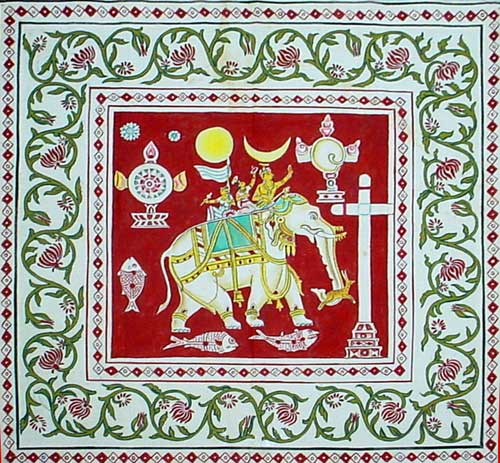Another important flag of the Karave is known as the ‘Manampitiya Banner’, since it was discovered in the Tamankaduwa area.

The image on left shows the Manampitiya Banner from the private collection of Mrs. M. G. Fernando, the author of the book ”Sri Lanka Flags – Unique Memorials of Heraldry”, 1980. The banner has been faithfully reproduced from the original found in Manampitiya, by a local artist A. Albert Appuhamy. The flag is listed as No 9 in Mrs. M. G. Fernando’s book on Sri Lankan flags.
The banner shows a mounted Elephant as the principal device with emblems of the Sun, Moon and Stars, the fish, a monstrance, a Pyx and very specially a crucifix. The flag has belonged to members of the Karava caste, long settled in the area Manampitiya, in the District of Tamankaduwa. The families have fled from the maritime provinces of Negombo, to avoid persecution by the Dutch. The flag itself may have originated in Portuguese times or much earlier. On conversion to Christianity the symbol of the cross and the Pyx have been added. Over a century later the families that settled in Manampitiya adopted the Hindu religion.
E. W. Perera in his book “The Banners and Standards of the Sinhalese” gives the original owner of this flag as one S U Kulasegeram Pillai, Udaiyar of Egoda Pattu , Tamankaduwa, who claims descent from Maha Vidiya & Wella Vidiya Mudaliyars of Negombo. The owners of the flag has been Hindu engaged in agriculture.
The area of Manampitiya and its Karava culture is best explained in M. D. Raghavan’s book ‘The Karava of Ceylon’. The following paragraphs have been reproduced from this book.
A topographical isolation of a different character, with a culture pronouncedly different is revealed in Manampitiya, of Egoda Pattuwa Kõrale, in Tammankaduwa District of the North Central Province. Park-like and dry, eight miles to the south of Manampitiya, is the jungle around “Gunner’s Quoin”(1), one of the ancestral homes of the Veddas. Between the villages of Gallela and Manampitiya flows the Mahaväligañga. In the middle ages when Polonnaruwa was the capital of the Sinhalese kings, from 1017 to 1235 A.D. Manampitiya was obviously a populous village sharing in the general prosperity of the age. The natural depressions on the surface of the soil have been developed into tanks by the hand of man, fostering the ancient cultivation of the region.
Abandoned by the Sinhalese from the time that Polonnaruwa ceased to be the capital of the Kingdom, Manampitiya was obviously left to nature, until its present inhabitants, Kurukulathar of Negombo, went into occupation of the land; one of the several bands of refugees escaping from the political and social upheavals of the Dutch times.
Whatever be the circumstances that led to the establishment of this far flung outpost of Karäva culture, here today is seen the traditional Hindu culture of the Karäva preserved for posterity, with the flags and banners of the group in the hands of these humble peasants and cultivators. These flags and banners are the living links of the Karäva all over Ceylon-the sacred insignia, which open up a vast field of study in Hindu symbolisms and signs. It was from this village and from these people that E. W. Perera collected his data on Karava flags for his monumental work, “The Banners and Standards of the Sinhalese”.
(1) Today this place is known as Dimbulagala.